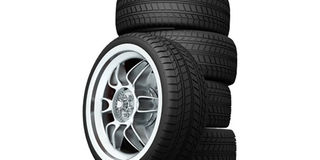Your choice of tyres matters

Always have the right type of tyre on your car. PHOTO/NET
What you need to know:
- Tyre pressure: Whatever the tyre size, pressure should stay between 28 to 36 psi. If on comfort, go for the lowest, that is 28psi. If you feel it is under inflated, too soft, no cornering stability, add more.
You shall be amazed by how people shop for tyres. In many people’s minds, shopping for tyres is no different from shopping for pineapples, get the cheapest as they all are the same, black and round. Some buyers do not even bother what readings are on the side wall, which is recommended.
There is an incredible amount of research that goes into just the rubber compound of specific tyres, long before any design considerations are made on how the tread works, how the belts overlap or how heavy duty the sidewall is.
Brand
Depending on your usage, you could destroy a cheap set of tyres in a day. Literally. If your mission is to take your car off-road, for example, and you have chosen a sub-standard brand of tyres, a sharp rock could easily puncture a hole in the sidewall and your day is over. This, among others, are the hazards that the brand name tyre manufacturers are hoping to protect you from when they invest money in research and development.
Type
Always have the right type of tyre on your car. I have seen many cars from Japan with winter tyres. These tyres operate within a specific temperature range that is way outside Uganda’s heat. Of course such a tyre shall, once the heat builds up, fail very suddenly and catastrophically.
Because it is the only part of the car that touches the road, the depth of tread on your tyres is important for the safety of your car. It also signals the health of the tyre. Driving with low tread depth increases the potential for tyre failure and aquaplaning (a condition where the tyres of a car lose physical contact with the road surface as they begin riding on a layer of water).
To understand the role of the tyre tread when it is wet, think of it as a water pump. The greater the number of channels in your tyre’s tread, the more it can pump water away between the contact patch and the road surface.
Duration
Generally speaking, tyre manufacturers recommend that tyres should not be used beyond six years after the date of manufacture, regardless of use. This is specific to buyers of used tyres. Always note the date of manufacture on the sidewall. The week and year the tyre was produced is provided by the last four digits of the Tyre Identification Number, with the two digits being used to identify the week immediately preceding the two digits used to identify the year.
Additionally, for new tyres, know that tyres deteriorate with age, even if they have never or seldom been used. Over time, the rubber in the tyre tread loses its elasticity and becomes hard and brittle. These tyres are dangerous even if the tread is still fine. So, it is never just about the tread looking good.
Never hesitate to replace a worn out or damaged tyre. Tyres are not cheap, but they are vital to your safety and that of your passengers. Remember that tyres are the only thing that connects your car to the road. Advanced safety features such as antilock brakes and electronic stability control cannot do their life-saving jobs without four good tyres. All things considered, check the overall condition of your tyres, particularly the tread and sidewalls, at least once a month.
Tried, tested brands
If you do not want to think about all the technicalities, simply go with what the manufacturer specifies. There is a reason that manufacturers specify a tyre of specific size, speed rating and tread wear, among others. For an old car, this information is available on the Internet. A good manufacturer has selected a tyre after a lot of testing, and choosing the specifications that will give the best compromise in all conditions.




